

Daruma: Gunma’s Good Luck Charm
|
Did you know Gunma prefectures has the largest production of daruma dolls in Japan? Before we explore why this is so, let us first take a look at the daruma’s features. These paper-mâché dolls have a distinct face, and you can actually see two auspicious animals if you examine closer. The eyebrows are drawn to resemble cranes, while the noses and moustaches are drawn to resemble turtles. As a Japanese saying goes, “the crane lives 1,000 years, the turtle 10,000”. Being a symbol of good luck, the daruma can have gold writing along the sides of its face, which would state the owner’s wish for achieving prosperity or a certain goal. There is also kanji characters written on the middle of the doll, such as “luck”, “fortune” or “perseverance”.
The shape of the daruma is round, such that even if it is knocked over, it will return to an upright position. This perfectly exemplifies the Japanese proverb “七転び八起き”, which literally means falling down seven times and getting up eight times. The daruma is typically red colour, as it represents good fortune and wards off evil spirits. However, it can come in other colours too, such as gold or yellow for wealth, and blue for academic success. Nowadays, you may also find daruma dolls designed in modern patterns. As you may notice, the daruma’s eyes are blank. This is because the owner is supposed to paint them in. There is no correct order to painting the eyes. However, it is said that you first colour its left eye while making a wish, as this signifies opening the eye of your mind. This is due to the Japanese saying “右に出る者はいない”, which means that there is no one standing on that person’s right, as there is no one else more outstanding. This is also reflected in seating arrangements in the past. By looking at the daruma with one painted eye, it reminds you of your wish and goal and motivates you. Once the wish is fulfilled, the other eye is painted in. Even if the wish is not fulfilled, you can still paint the other eye after a successful year without any incidents. The act of restoring its eyesight is akin putting its soul in. It is said that daruma originated from Shorinzan Darumaji Temple in Gunma prefecture. The temple distributed images of Bodhidharma, who is considered as the founder of Zen Buddhism, as good luck charms. When a famine occurred around 200 years ago, a temple monk created a doll mold, so that the farmers could sell them as a side business especially during the winter season. These dolls proved to be popular with silk farmers, whose livelihoods depended on luck. The shape of the original dolls still had a curve between the head and torso, and resembled a human figure. It was only in the early Meiji era, that the roly-poly shape was created. The fact that daruma does not have any limbs, also resembles Bodhidharma, who supposedly lost his limbs from nine years of meditation. Moreover, the word “daruma” comes from the Japanese pronunciation of “Dharma”. Today, Takasaki city in Gunma prefecture produces around 80% of Japan’s daruma. Besides historical reasons, the climate is another critical factor. The strong winds and dry air create ideal conditions for the manufacturing process, in which layers of washi (traditional Japanese paper) are stuck onto a wooden daruma mold. Takasaki Daruma Market is held annually on 1st and 2nd of January. Thousands of visitors flock there to enjoy food, entertainment, and obtain their own daruma. Other than Takasaki city, daruma is also significant in the capital city of Gunma, Maebashi. Since the 1600s, a popular festival, Hatsuichi Matsuri, has been held there every January. People would bring their old daruma and burn them in a bonfire, offering thanks for past achievements and praying for good luck in the new year. After that, people would also buy a new daruma for the new year. If you have made New Year’s resolutions, why not consider getting a daruma of your own to motivate yourself and help you achieve them? |
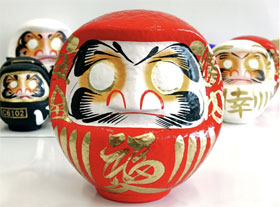 © Takasaki City 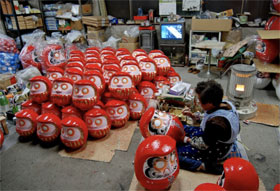 © Takasaki City 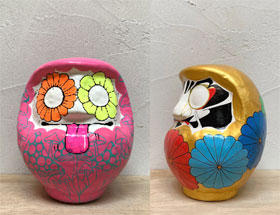 © Utageya ART Daruma 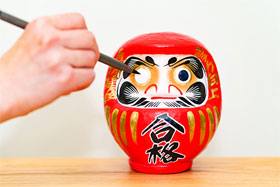 © Web Japan 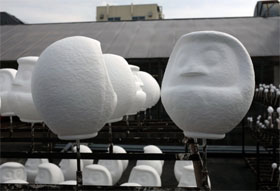 © Takasaki City 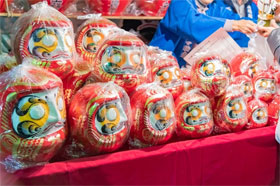 © Japan Up Close |
Resources
|
“Have You Ever Heard of a Lucky Daruma?” 2023. Web Japan. Accessed 14 March. https://web-japan.org/trends/11_fashion/fas202302_daruma.html. “Takasaki Daruma Dolls: A Gunma Icon”. 2023. Gunma Prefectural Government. Accessed 14 March. https://www.visit-gunma.jp/en/discover/stories-and-guides/takasaki-daruma-dolls-gunma-icon/. “Takasaki Daruma”. 2023. Takasaki Daruma. Accessed 14 March. https://takasakidaruma.net/multilingual/english/. “Takasaki Daruma”. 2023. City of Takasaki. Accessed 14 March. https://artsandculture.google.com/story/takasaki-daruma-city-of-takasaki/iwWBdP-p-nmkKA?hl=en. “Hatsuichi Matsuri Daruma Festival”. 2023. Japan National Tourism Organization. Accessed 14 March. https://www.japan.travel/en/spot/307/. |
|
Japan Creative Centre 4 Nassim Road, Singapore 258372 +65 6737 0434 / jcc@sn.mofa.go.jp https://www.sg.emb-japan.go.jp/JCC/ Nearest parking at Orchard Hotel & Delphi Orchard |
 |